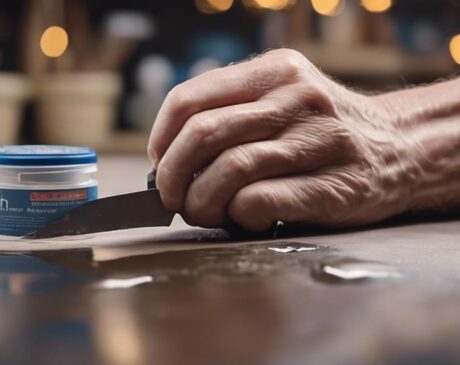Why Does Top Coat Take off Polish?

When you put on top coat, the solvents can mess with the layers below, causing smudges or removal of the polish. Always let each layer dry completely before adding top coat. Different top coats may not work well with certain polishes, so choose wisely. Quick-drying options can help prevent polish problems. By understanding these interactions, you can keep your manicure looking great. Further details on the impacts of solvent effects and drying time can help you improve your nail care routine.
Key Takeaways
- Solvents in top coat can dissolve or mix with wet polish layers, causing smudging or streaking.
- Incompatibility between top coat and polish can lead to lifting or removal of the polish.
- Ensure all polish layers are completely dry before applying top coat to prevent interaction.
- Some top coats may contain harsh chemicals that weaken the bond between layers of polish.
- Quick-drying top coats reduce vulnerability time and minimize the risk of polish removal.
Chemical Composition of Top Coat

When you apply a top coat, it forms a protective layer over your nail polish, consisting of specific chemicals that play a key role in its functionality. These chemicals are designed to enhance the durability and shine of your manicure. One crucial component found in many top coats is ethyl acetate, which helps the top coat dry quickly and adhere well to the nail surface. Additionally, butyl acetate is often present to contribute to the smooth application of the top coat.
Another essential chemical in the top coat is nitrocellulose, which aids in creating a hard and protective layer over your nail polish. This layer acts as a shield, guarding your manicure against chips, scratches, and fading. By understanding the chemical composition of your top coat, you can appreciate the science behind its ability to keep your nails looking fresh and vibrant for an extended period.
Interaction With Fresh Polish Layers
As you apply fresh layers of nail polish, the interaction with the top coat can significantly impact the overall longevity and appearance of your manicure. When you apply a top coat over wet nail polish, the solvents in the top coat can penetrate the layers, causing them to mix. This mixing can lead to smudging, streaking, or even completely removing the fresh polish layers.
To avoid this, make sure each layer of polish is completely dry before applying the top coat. Additionally, the type of top coat you use can also affect how well it interacts with the fresh polish layers. Some top coats are specifically formulated to work well with certain types of nail polish, while others may not be compatible.
Experimenting with different combinations can help you find the best match for a long-lasting and flawless manicure. Remember, taking the time to understand how these products interact can make a big difference in the final look of your nails.
Solvent Effects on Nail Lacquer

To understand the impact of solvents on nail lacquer, consider how these chemicals affect the composition and durability of your manicure. Solvents are the magic ingredients that keep your nail polish in a liquid state until it dries on your nails.
When you apply nail lacquer, solvents evaporate, leaving behind the colored pigments and polymers that form the protective layer on your nails. However, solvents can also be a double-edged sword. They play a crucial role in the application process by making the polish easy to spread, but they can also weaken the bond between layers of polish.
This weakening effect is why certain top coats or nail polish removers containing solvents can inadvertently strip away your carefully applied manicure. Understanding how solvents interact with nail lacquer can help you choose products that strike the right balance between ease of application and long-lasting wear.
Impact of Drying Time
Consider how different drying times affect the longevity of your manicure and the overall quality of your nail lacquer.
- Quick Dry: Opting for a quick-drying top coat can help prevent smudges and nicks, ensuring your polish sets faster and lasts longer.
- Air Drying: Allowing your nail polish to air dry naturally might take more time, but it can lead to a more durable and chip-resistant finish.
- Avoiding Heat: While using heat like a blow dryer can speed up the drying process, it may compromise the integrity of the polish, making it prone to chipping sooner.
Choosing the right drying method for your nail lacquer can significantly impact how well your manicure holds up. Experiment with different drying techniques to find what works best for you and gives you the long-lasting results you desire.
Tips to Prevent Polish Removal

To keep your polish intact for longer periods, ensure you apply a high-quality top coat and avoid certain activities that can lead to premature removal. When applying the top coat, make sure it fully covers the edges of your nails to create a seal that protects the polish underneath.
Opt for top coats labeled as quick-dry to minimize the time your nails are vulnerable. Additionally, be mindful of the products you use daily. Harsh chemicals in cleaning products can weaken the polish, so wearing gloves during chores can help maintain your manicure.
Avoid prolonged exposure to water, especially hot water, as it can cause the polish to lift. When engaging in activities like gardening or crafting, consider wearing gloves to shield your nails from potential damage.
Frequently Asked Questions
Can I Use Top Coat as a Base Coat for My Nail Polish?
Yes, you can use a top coat as a base coat for your nail polish. It helps to create a smooth surface and prolongs the wear of your polish. Why not try it out and see the difference for yourself?
How Long Should I Wait Before Applying Top Coat Over My Nail Polish?
Wait at least 5-10 minutes before applying top coat over your nail polish. This allows the polish to dry properly, ensuring a smooth and long-lasting finish. Rushing can lead to smudges and a less durable manicure.
Will Using a Quick-Dry Top Coat Affect the Longevity of My Manicure?
Using a quick-dry top coat can affect your manicure's longevity. While speeding up drying time, some formulas may not provide the same durability as regular top coats. Experiment to find what works best for you.
Are There Any Specific Nail Polish Formulas That Are More Prone to Being Removed by Top Coat?
Certain nail polish formulas, like those with weaker bonds or solvents, may be more susceptible to being removed by top coat. Experiment with different brands to find one that maintains its integrity with a top coat.
Can Applying Multiple Layers of Top Coat Cause My Nail Polish to Chip or Peel More Easily?
Applying multiple layers of top coat can indeed cause your nail polish to chip or peel more easily. Remember, balance is key. Overdoing it with top coat may lead to faster wear and tear.




